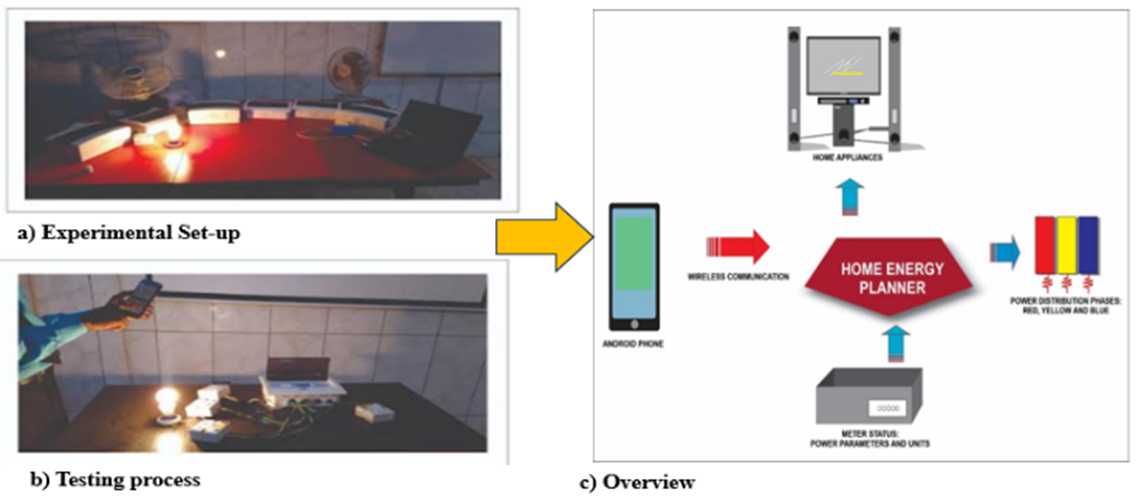User-Centric Design for Automated Metering Power Management Systems: A Case Study in Nigeria
DOI:
https://doi.org/10.58190/ijamec.2025.115Keywords:
Automation, Innovation, Monitoring, Power ManagementAbstract
Nigeria continues to face persistent power management challenges, with frequent outages affecting both urban and rural areas. Technical issues, such as open-circuit faults, contribute to significant losses in the low-voltage section of the power distribution system. Additionally, the lack of transparency in the current power management system fosters distrust between electricity consumers and providers. This study presents the Automated Metering Power Management System (AMPMS)—an integrated solution designed to improve energy monitoring, fault detection, and consumption planning. The system incorporates an automated digital meter, a Home Energy Planner (HEP), a web-based platform, and the "Meter Utility" mobile app to enhance energy management. The AMPMS utilizes a Hall effect current sensor, voltage sensor, Wi-Fi module, and Atmega328p microcontroller, enabling real-time fault detection, outage reporting, and load scheduling. Evaluation results demonstrate the system’s effectiveness in reducing power consumption. Households using the AMPMS recorded an energy consumption of 3.02 kWh, significantly lower than the 4.442 kWh observed with conventional prepaid meters—a 31.9% reduction. Furthermore, survey data revealed that 96.3% of respondents experienced delays in resolving open-circuit faults under the existing system, underscoring the need for an automated fault detection and reporting mechanism. By integrating these components, the proposed AMPMS improves power distribution accuracy, enhances consumer control over energy usage, and reduces downtime. The system is scalable for residential, small office, and potential industrial applications in developing nations. This research provides a practical and technologically driven approach to addressing Nigeria’s energy management challenges, promoting efficiency, transparency, and accountability in power distribution.
Downloads
References
[1] International Energy Agency (IEA). (2021). World energy outlook 2021. https://www.iea.org/reports/world-energy-outlook-2021
[2] Jain, M., Gupta, S., & Saini, A. (2019). LoRa RF technology for automated energy metering. International Journal of Electrical Power and Energy Systems, 112, 476–483.
[3] Adaramola, M. S., Oyewola, O. M., & Fagbenle, R. O. (2020). Energy sustainability in Nigeria: Challenges and prospects. Energy Policy, 150, 112-126.
[4] Ogbuanya T.C and Nuhu I.N. (2021). Effectiveness of energy conservation awareness package on energy conservation behaviors of off-campus students in Nigerian universities. Sage Journal, 1415-1428.
[5] Olayinka, A., & Babatunde, M. (2018). Prepaid meters and energy management in Nigeria: A critical analysis. African Journal of Energy and Environmental Studies, 13(2), 57–64.
[6] Elavarasan, R. M., Pugazhendhi, R., Jamal, T., & Kumar, A. (2020). Smart energy management solutions for energy efficiency. Renewable and Sustainable Energy Reviews, 136, 110564.
[7] Norman, D. A. (2013). The design of everyday things (Revised and expanded edition). Basic Books
[8] Adebayo, T. (2019). Energy consumption patterns in urban and rural Nigeria. Journal of Energy and Environment, 45(3), 231–245.
[9] Coughlin, K.,White R., and Bolduc, C. (2006). Analysis Project: A database and Analysis platform for electricity tariffs, Energy Analysis.
[10] Odior, E. O.James K.,, and Udoh, E. (2010). An Intelligent Power Load Control/Switching System Using an Energy Meter and Relay Circuit. International Journal of Grid and High-Performance Computing (IJGHPC), 8(1), 76-84.
[11] Apeh, S. T., and Mokogwu, C. N. (2013). Development of home power management system. Nigerian Journal of Technological Research, 8(2), 30-34.
[12] Georgievski, I., Degeler, V., Pagani, G. A., Nguyen, T. A., Lazovik, A., and Aiello, M. (2012). Optimizing energy costs for offices connected to the smart grid. IEEE Transactions on Smart Grid, 3(4), 2273-2285.
[13] Nguyen, J., Yap, K. S., Tiong, S. K., Ahmed, S. K., and Mohamad, M. (2013). Nontechnical loss detection for metered customers in power utility using support vector machines. IEEE Transactions on Power Delivery, 25(2), 1162-1171.
[14] Yutami, T. (2014). ICT technologies standards and protocols for the active distribution network. In Smart power distribution systems (pp. 205-230). Academic Press.
[15] Oseni, M. O. (2015). Smart metering for accurate energy consumption monitoring. Nigerian Journal of Energy Studies, 5(2), 45-58.
[16] Zhang, Y., Wei, J., Zhu, Y., and George-Ufot, G. (2020). Untangling the relationship between Corporate Environmental Performance and Corporate Financial Performance: The double-edged moderating effects of environmental uncertainty. Journal of Cleaner Production, 263, 1-39.
[17] Fabiano, S., Khajepour, A., and Gerlich, A. (2015). Analysis of Power Consumption Structures Africa.. The International Journal of Advanced Manufacturing Technology, 82, 1173-1186
[18] Massaki, S. N., Singh, B. K., and Kumar, V. (2017). A survey on secure transmission in the Internet of things: taxonomy, recent techniques, research requirements, and challenges. Arabian Journal for Science and Engineering, 45, 6211-6240
[19] Sperando, L. G., and Lopez, V. I. (2018). Modeling of end-use energy consumption in the residential sector: A review of modeling techniques. Renewable and sustainable energy reviews, 13(8), 1819-1835.
[20] Liu, Y., Ma, X., Shu, L., Hancke, G. P., and Abu-Mahfouz, A. M. (2020). From Industry 4.0 to Agriculture 4.0: Current status, enabling technologies, and research challenges. IEEE Transactions on Industrial Informatics, 17(6), 4322-433
[21] Mukovhe, M. S., Zaki, S. A., Rijal, H. B., Hagishima, A., and Ali, M. S. M. (2023). Thermal comfort and occupant adaptive behaviour in Japanese university buildings with free running and cooling mode offices during summer. Building and Environment, 105, 332-342.
[22] Seongwoo Lee, M., Murari, K., Rege, A., Cauwenberghs, G., and Thakor, N. V. (2024). VLSI potentiostat array with oversampling gain modulation for wide-range neurotransmitter sensing. IEEE Transactions on Biomedical Circuits and Systems, 1(1), 63-72.

Downloads
Published
Issue
Section
License
Copyright (c) 2025 International Journal of Applied Methods in Electronics and Computers

This work is licensed under a Creative Commons Attribution-ShareAlike 4.0 International License.




